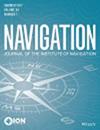使用高速率基于DFT的数据操纵器(HDDM)的GNSS接收机的先进和通用信号调理
IF 2
3区 地球科学
Q1 ENGINEERING, AEROSPACE
引用次数: 4
摘要
正确的信号调理是全球卫星导航系统(GNSS)可靠导航的关键。信号调理包括纠正接收机前端畸变、整形噪声、去除干扰和改变接收信号。基于离散傅里叶变换的高速数据操纵器(HDDM)是一种基于离散傅里叶变换(DFT)的通用信号处理体系结构。本文对HDDM进行了理论建模、分析和评估。介绍了一些应用,包括干扰缓解、频谱重建、覆盖信号设计、改变信号调制和信号均衡。此外,还研究了一个具体硬件实现的复杂性。HDDM在抑制干扰方面取得了良好的效果,并可同时完成其他信号调理任务。与离散处理体系结构相比,使用相同的嵌套体系结构处理多个任务提供了显著的处理优势。它强调了同时处理多个信号条件任务的单一架构的好处,而不是需要大量处理或较差协同作用的独立结构。本文章由计算机程序翻译,如有差异,请以英文原文为准。
Advanced and versatile signal conditioning for GNSS receivers using the high‐rate DFT‐based data manipulator (HDDM)
Proper signal conditioning is crucial for reliable Global Navigation Satellite System (GNSS) navigation. Signal conditioning includes correcting receiver front-end distortions, shaping noise, removing interferences, and altering the received signal. The high-rate DFT-based data manipulator (HDDM) is a versatile signal processing architecture based on the Discrete Fourier Transform (DFT). In this article, the HDDM is theoretically modeled, analyzed, and evaluated. Some applications are presented, including interference mitigation, spectrum reconstruction, overlay signal design, altering signal modulations, and signal equalization. Additionally, the complexity of one concrete hardware implementation is investigated. The HDDM has shown excellent results with interference mitigation, and it can simultaneously achieve other signal conditioning tasks. Processing several tasks with the same nested architecture provides a significant processing benefit compared to discrete processing architectures. It emphasizes the benefits of a single architecture to simultaneously address several signal condition tasks, as opposed to separate structures requiring significantly more processing or poorer synergy.
求助全文
通过发布文献求助,成功后即可免费获取论文全文。
去求助
来源期刊

Navigation-Journal of the Institute of Navigation
ENGINEERING, AEROSPACE-REMOTE SENSING
CiteScore
5.60
自引率
13.60%
发文量
31
期刊介绍:
NAVIGATION is a quarterly journal published by The Institute of Navigation. The journal publishes original, peer-reviewed articles on all areas related to the science, engineering and art of Positioning, Navigation and Timing (PNT) covering land (including indoor use), sea, air and space applications. PNT technologies of interest encompass navigation satellite systems (both global and regional), inertial navigation, electro-optical systems including LiDAR and imaging sensors, and radio-frequency ranging and timing systems, including those using signals of opportunity from communication systems and other non-traditional PNT sources. Articles about PNT algorithms and methods, such as for error characterization and mitigation, integrity analysis, PNT signal processing and multi-sensor integration, are welcome. The journal also accepts articles on non-traditional applications of PNT systems, including remote sensing of the Earth’s surface or atmosphere, as well as selected historical and survey articles.
 求助内容:
求助内容: 应助结果提醒方式:
应助结果提醒方式:


